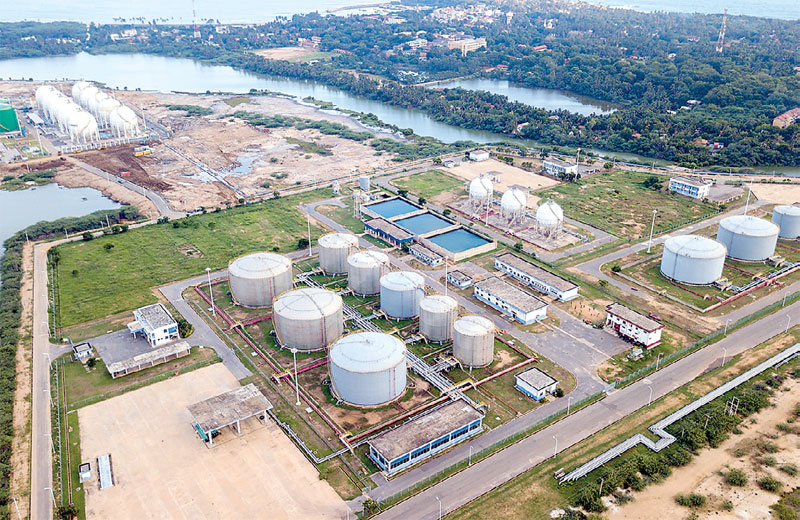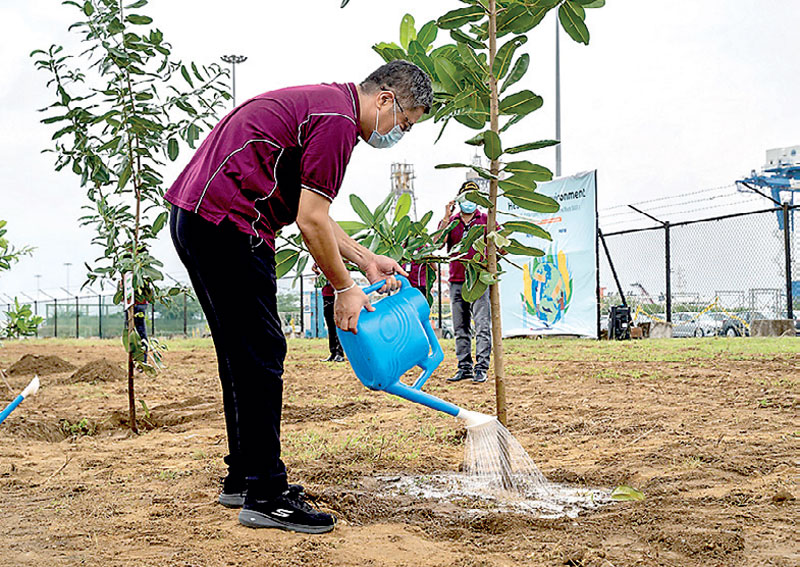Wednesday Mar 05, 2025
Wednesday Mar 05, 2025
Monday, 14 February 2022 02:43 - - {{hitsCtrl.values.hits}}

The year 2021 was a watershed year for HIP with the port's activities spreading in several new directions, which has created a unique ecosystem for economic prosperity for Sri Lanka.
The port worked to provide opportunities for maritime trade and investment on the East-West routes of the Indian ocean.
HIP which is slated to become a top-notch multipurpose port is uniquely positioned to be a catalyst for the industrial development of the south of Sri Lanka through its industrial park situated within the port and adjacent development activities earmarked by the government of Sri Lanka.
The port is rapidly building capacity in the areas of port services and operations, investment, industrial zone, and bonded facilities, marking several notable milestones throughout the past year.
HIP Speed
A lot of the port’s recent successes can be attributed to its agility formula ‘HIP Speed’ introduced by the Hambantota International Port Group CEO Johnson Liu.
It is the blueprint to spur development in every direction of the port’s activities, and specially designed to clear bottlenecks and build processes that do not stand in the way of implementing projects on time.
With HIP Speed, the port has much tighter deadlines to complete projects, which has helped considerably in bringing desirable investment to the port.
CEO Johnson Liu says: “HIP Speed has brought a new dimension to investment in port operations and allied industries.
We put this formula in place taking into consideration the opportunities that will emerge in the coming years, when supply and demand structures will change and trade routes will be reinvented. HIP speed is an essential ingredient and catalyst to drive the dynamic needs of the supply chain industry under the new normal.”
On the heels of the HIP Speed initiative, came support from the state sector, with agencies like the Board of Investment (BOI) and Industrial Development Board (IDB), setting up offices in the port’s main administration building.
Cargo handling
Although challenges posed by the pandemic continued, HIP achieved an overall throughput of 2.3 million metric tons of cargo, with a remarkable 38 % increase in RORO operations.
The introduction of effective new strategies and partnerships with new RORO lines for transhipment cargo, helped HIP achieve the landmark 535,000 units of small and large vehicles handled in 2021.
The transhipped vehicles, mainly manufactured in India, Thailand, Japan and Korea are destined for Africa, the Middle East, Far East and South America.
The port also saw a significant 59 % increase in bulk cargo handled, exceeding the 1 million MT mark of dry bulk handled in a single year.
Bunkering operation
The wholesale supply of Marine Bunker fuels kicked off by HIP and strategic partner Sinopec Fuel Oil Lanka Ltd., during the previous year, saw a sharp increase in bunkering by end 2021.
With the port’s 14 tank oil storage network, oil jetties and ancillary infrastructure fully operational, HIP is now geared to provide VLSFO and MGO fuel bunkering services for vessels plying the principal sea routes in the Indian Ocean.
With the International Maritime Organisation (IMO) pushing the maritime industry to reduce emissions, the port is geared to offer the best quality low sulphur fuels to the market, underlining its goal of positioning as a bunkering hub in South Asia.
Towards this end, the port also established a marine oil testing laboratory at the oil tank facility, in collaboration with a renowned international partner. Thus, this enables the provision of international standards of quality at the supply source.
Port investment
HIP has engaged in developing its industrial zone, which is well set to become a catalyst for industrial development in the island’s south.
The past year saw a number of new investment agreements signed with local and global partners to bring valuable industries to the country.
Amongst the top players setting up operations within the port are the Xinji Shenzhen Group, Ceylon Tire Manufacturing Company, SeaHorse Yachts, and Lanwa Cement.
The Xinji Group’s plug and play, park in park facility, which kicked off within 20 days of signing the agreement is nearing completion and work is well underway for the $ 300 million tire manufacturing project.
Amongst projects in the pipeline are a bonded warehousing network and a container terminal which will add to the port’s multi-purpose services.
Building win-win relationships
2021 saw a number of local and international dignitaries visiting the port.
The CEO and the management team hosted the Prime Minister and his delegation in the latter part of the year, while several high officials from Ministries, Embassies, State and International Institutions also toured the port during different intervals.
HIP also signed TSA's with several international shipping lines enhancing stakeholder cooperation and working towards increasing volumes shipped via HIP.
While HIP Speed helped to re-energise all aspects of port activities, achieving set goals brought HIP staff together in more ways than one. It was a year of bonding for management and staff who were rewarded for their work ethic.
A number of incentives and awards schemes were introduced, with ‘CEO Awards’ and ‘CMPort Awards’ to recognise excellence, key amongst them.
HIP is the only port in Sri Lanka, to receive the ISO Integrated Management System standards certificate for its quality, environmental consciousness and adherence to health and safety protocols, which follow international benchmarks set by the port operator's parent company CMPort.
COVID-19 response
The port provided funding to establish a fully-fledged PCR testing laboratory at the Hambantota District General Hospital last year.
Part of the funding for the PCR testing facility comes from China Merchants Foundation (CMF), the philanthropic arm of Hambantota International Port Group’s (HIPG) main shareholder, CMPort.
Many donations of personal protection equipment were also made to government institutions in Hambantota.
HIP’s own response to managing the spread internally has been exemplary.
The management adapted a two pronged strategy i.e. a people first approach and an initiative to manage workplace protocols. This was very strategically done, and the port was able to keep infection rates far below the nationwide average, creating a safe work environment for staff.
People Planet
HIP continued its CSR programs, throughout 2021 keeping to its long-term vision of caring for People and Planet while achieving business objectives.
Completing over 14 CSR projects during the year, they closed 2021 with a pledge to set up a fund that will manage the human elephant conflict that has long troubled the Hambantota district.
The project is a partnership with the Hambantota District Secretariat, who will collaborate with the Department of Wildlife to take mitigatory action for which HIPG will provide the funding.
As CEO Johnson Liu said, the port fully supports the endeavour which is a sustainable approach to end the conflict and declare peace between humans and elephants.
Another important sustainability project launched by the Port was its first integrated solid waste management initiative under the theme ‘Healing the Environment’.
The initiative is a strategic approach to sustainably manage biodegradable solid waste. The process covers the source, generation, segregation, transfer, sorting, treatment, recovery and disposal of waste in an integrated manner.
‘Healing the Environment’ also included growing and nurturing endemic trees that will enrich the biodiversity of the industrial zone and port premises.
Apart from the above key projects, the port has worked on building better relationships with adjacent communities, hospitals, all religious establishments and fostering Buddhism with the exchange of relics from China etc.
HIP’s ongoing ‘Hope Village’ project has also played a vital role in uplifting community lives.




Discover Kapruka, the leading online shopping platform in Sri Lanka, where you can conveniently send Gifts and Flowers to your loved ones for any event including Valentine ’s Day. Explore a wide range of popular Shopping Categories on Kapruka, including Toys, Groceries, Electronics, Birthday Cakes, Fruits, Chocolates, Flower Bouquets, Clothing, Watches, Lingerie, Gift Sets and Jewellery. Also if you’re interested in selling with Kapruka, Partner Central by Kapruka is the best solution to start with. Moreover, through Kapruka Global Shop, you can also enjoy the convenience of purchasing products from renowned platforms like Amazon and eBay and have them delivered to Sri Lanka.
Discover Kapruka, the leading online shopping platform in Sri Lanka, where you can conveniently send Gifts and Flowers to your loved ones for any event including Valentine ’s Day. Explore a wide range of popular Shopping Categories on Kapruka, including Toys, Groceries, Electronics, Birthday Cakes, Fruits, Chocolates, Flower Bouquets, Clothing, Watches, Lingerie, Gift Sets and Jewellery. Also if you’re interested in selling with Kapruka, Partner Central by Kapruka is the best solution to start with. Moreover, through Kapruka Global Shop, you can also enjoy the convenience of purchasing products from renowned platforms like Amazon and eBay and have them delivered to Sri Lanka.